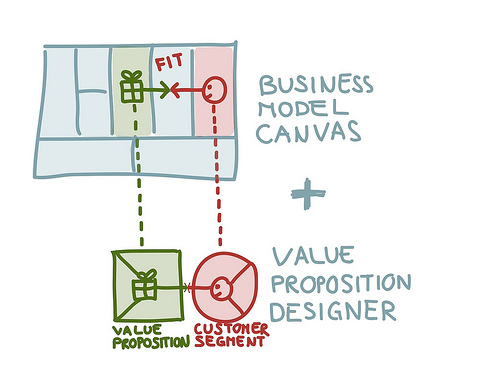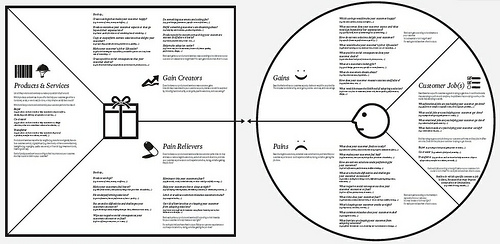Achieve Product-Market Fit with our Brand-New Value Proposition Designer Canvas
Blog: Business Model Alchimist
I’m a big fan of the Lean Startup movement and love the underlying principle of testing, learning, and pivoting by experimenting with the most basic product prototypes imaginable – so-called Minimal Viable Products (MVP) – during the search for product-market fit. It helps companies avoid building stuff that customers don’t want. Yet, there is no underlying conceptual tool that accompanies this process. There is no practical tool that helps business people map, think through, discuss, test, and pivot their company’s value proposition in relationship to their customers’ needs. So I came up with the Value Proposition
DesignerCanvas together with Yves Pigneur and Alan Smith.
The Value Proposition Designer Canvas is like a plug-in tool to the Business Model Canvas. It helps you design, test, and build your company’s Value Proposition to Customers in a more structured and thoughtful way, just like the Canvas assists you in the business model design process (I wrote more about how we came up with this new tool previously).
The Canvas with its 9 building blocks focuses on the big picture. The Value Proposition Designer Canvas zooms in on two of those building blocks, the Value Proposition and the Customer Segment, so you can describe them in more detail and analyze the “fit” between them. Companies need to get both right, the “fit” and the business model, if they don’t want to go out of business, as I described in an earlier post on failure. The tools work best in combination. One does not replace the other.
In this post I’ll explain the conceptual tool. In my next post I’ll outline how you can use it for testing in combination with the Customer Development process by Steve Blank and the Lean Start-up process by Eric Ries. The Value Proposition Designer Canvas will allow you to better describe the hypotheses underlying Value Propositions and Customers, it will prepare you for customer interviews, and it will guide you in the testing and pivoting.
The Value Proposition Designer Canvas
As mentioned above, the Value Proposition Designer Canvas is composed of two blocks from the Business Model Canvas, the Value Proposition and the corresponding Customer Segment you are targeting. The purpose of the tool is to help you sketch out both in more detail with a simple but powerful structure. Through this visualization you will have better strategic conversations and it will prepare you for testing both building blocks.
Achieving Fit
The goal of the Value Proposition Designer Canvas is to assist you in designing great Value Propositions that match your Customer’s needs and jobs-to-be-done and helps them solve their problems. This is what the start-up scene calls product-market fit or problem-solution fit. The Value Proposition Designer Canvas helps you work towards this fit in a more systematic way.
Customer Jobs
First let us look at customers more closely by sketching out a customer profile. I want you to look at three things. Start by describing what the customers you are targeting are trying to get done. It could be the tasks they are trying to perform and complete, the problems they are trying to solve, or the needs they are trying to satisfy.
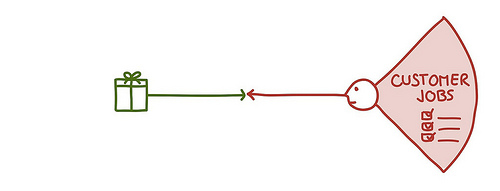
Ask yourself:
- What functional jobs is your customer trying get done? (e.g. perform or complete a specific task, solve a specific problem, …)
- What social jobs is your customer trying to get done? (e.g. trying to look good, gain power or status, …)
- What emotional jobs is your customer trying get done? (e.g. esthetics, feel good, security, …)
- What basic needs is your customer trying to satisfy? (e.g. communication, sex, …)
Customer Pains
Now describe negative emotions, undesired costs and situations, and risks that your customer experiences or could experience before, during, and after getting the job done.
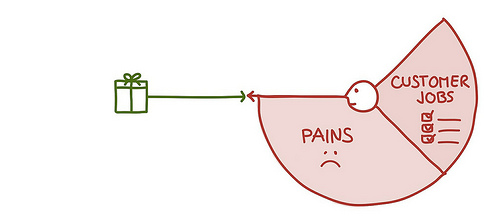
Ask yourself:
- What does your customer find too costly? (e.g. takes a lot of time, costs too much money, requires substantial efforts, …)
- What makes your customer feel bad?(e.g. frustrations, annoyances, things that give them a headache, …)
- How are current solutions underperforming for your customer? (e.g. lack of features, performance, malfunctioning, …)
- What are the main difficulties and challenges your customer encounters? (e.g. understanding how things work, difficulties getting things done, resistance, …)
- What negative social consequences does your customer encounter or fear? (e.g. loss of face, power, trust, or status, …)
- What risks does your customer fear? (e.g. financial, social, technical risks, or what could go awfully wrong, …)
- What’s keeping your customer awake at night? (e.g. big issues, concerns, worries, …)
- What common mistakes does your customer make? (e.g. usage mistakes, …)
- What barriers are keeping your customer from adopting solutions? (e.g. upfront investment costs, learning curve, resistance to change, …)
Rank each pain according to the intensity it represents for your customer. Is it very intense or is it very light. For each pain indicate how often it occurs.
Customer Gains
Now describe the benefits your customer expects, desires or would be surprised by. This includes functional utility, social gains, positive emotions, and cost savings.
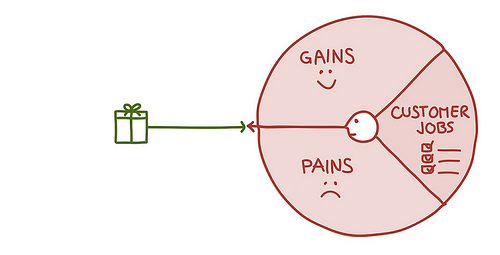
Ask yourself:
- Which savings would make your customer happy? (e.g. in terms of time, money and effort, …)
- What outcomes does your customer expect and what would go beyond his/her expectations? (e.g. quality level, more of something, less of something, …)
- How do current solutions delight your customer? (e.g. specific features, performance, quality, …)
- What would make your customer’s job or life easier? (e.g. flatter learning curve, more services, lower cost of ownership, …)
- What positive social consequences does your customer desire? (e.g. makes them look good, increase in power, status, …)
- What are customers looking for? (e.g. good design, guarantees, specific or more features, …)
- What do customers dream about? (e.g. big achievements, big reliefs, …)
- How does your customer measure success and failure? (e.g. performance, cost, …)
- What would increase the likelihood of adopting a solution? (e.g. lower cost, less investments, lower risk, better quality, performance, design, …)
Rank each gain according to its relevance to your customer. Is it substantial or is it insignificant? For each gain indicate how often it occurs.
Products & Services
Now that you sketched out a profile of your Customer, let’s tackle the Value Proposition. Again, I want you to look at three things. First, list all the products and services your value proposition is built around.
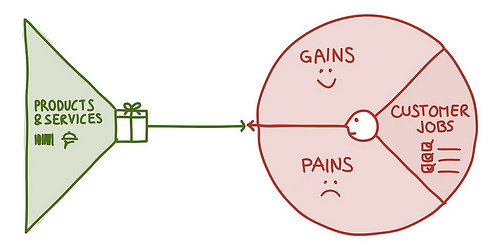
Ask yourself which products and services you offer that help your customer get either a functional, social, or emotional job done, or help him/her satisfy basic needs?
Products and services may either by tangible (e.g. manufactured goods, face-to-face customer service), digital/virtual (e.g. downloads, online recommendations), intangible (e.g. copyrights, quality assurance), or financial (e.g. investment funds, financing services).
Rank all products and services according to their importance to your customer. Are they crucial or trivial to your customer?
Pain Relievers
Now lets outline how your products and services create value. First, describe how your products and services alleviate customer pains. How do they eliminate or reduce negative emotions, undesired costs and situations, and risks your customer experiences or could experience before, during, and after getting the job done?
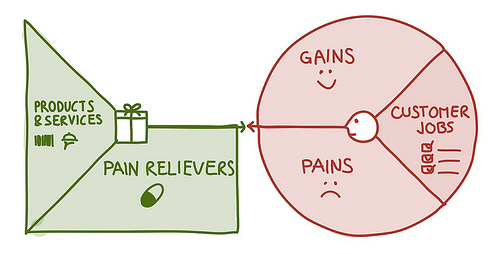
Ask yourself if they…
- … produce savings? (e.g. in terms of time, money, or efforts, …)
- … make your customers feel better? (e.g. kills frustrations, annoyances, things that give them a headache, …)
- … fix underperforming solutions? (e.g. new features, better performance, better quality, …)
- … put an end to difficulties and challenges your customers encounter? (e.g. make things easier, helping them get done, eliminate resistance, …)
- … wipe out negative social consequences your customers encounter or fear? (e.g. loss of face, power, trust, or status, …)
- … eliminate risks your customers fear? (e.g. financial, social, technical risks, or what could go awfully wrong, …)
- … help your customers better sleep at night? (e.g. by helping with big issues, diminishing concerns, or eliminating worries, …)
- … limit or eradicate common mistakes customers make? (e.g. usage mistakes, …)
- … get rid of barriers that are keeping your customer from adopting solutions? (e.g. lower or no upfront investment costs, flatter learning curve, less resistance to change, …)
Rank each pain your products and services kill according to their intensity for your customer. Is it very intense or very light? For each pain indicate how often it occurs.
Gain Creators
Finally, describe how your products and services create customer gains. How do they create benefits your customer expects, desires or would be surprised by, including functional utility, social gains, positive emotions, and cost savings?
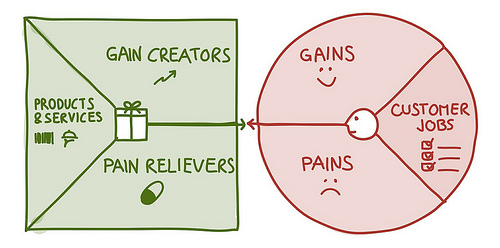
Ask yourself if they…
- …create savings that make your customer happy? (e.g. in terms of time, money and effort, …)
- … produce outcomes your customer expects or that go beyond their expectations? (e.g. better quality level, more of something, less of something, …)
- … copy or outperform current solutions that delight your customer? (e.g. regarding specific features, performance, quality, …)
- … make your customer’s job or life easier? (e.g. flatter learning curve, usability, accessibility, more services, lower cost of ownership, …)
- … create positive social consequences that your customer desires? (e.g. makes them look good, produces an increase in power, status, …)
- … do something customers are looking for? (e.g. good design, guarantees, specific or more features, …)
- … fulfill something customers are dreaming about? (e.g. help big achievements, produce big reliefs, …)
- … produce positive outcomes matching your customers success and failure criteria? (e.g. better performance, lower cost, …)
- … help make adoption easier? (e.g. lower cost, less investments, lower risk, better quality, performance, design, …)
Rank each gain your products and services create according to its relevance to your customer. Is it substantial or insignificant? For each gain indicate how often it occurs.
Competing for Customers
Most Value Propositions compete with others for the same Customer Segment. I like thinking of this as an “open slot” that will be filled by the company with the best fit. The visualization for this was an idea by Alan Smith, one of my co-founders, and the designer of Business Model Generation.
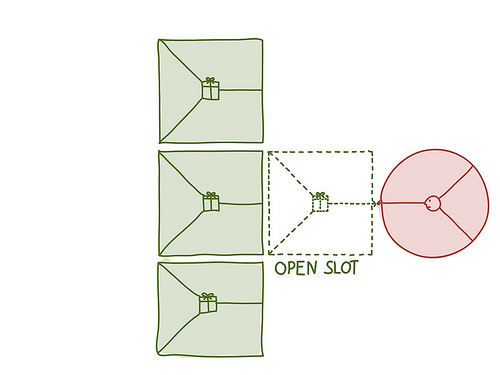
If you sketch out competing value propositions, you can easily compare them by mapping out the same variables (e.g. price, performance, risk, service quality, etc.) on a so-called strategy canvas.
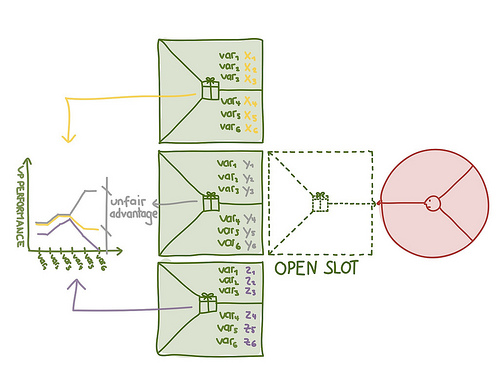
The Value Proposition Designer Canvas Poster
You can use the Value Proposition Designer Canvas like the Business Model Canvas: plot it as a poster, then stick it up on the wall, and then use sticky notes to start sketching.
Contrary to the Canvas, the Value Proposition Designer Canvas poster and methodology is copyrighted. However, you are free to use it and earn money with it as an entrepreneur, consultant, or executive, as long as you are not a software company (the latter need to license it from us). However, when you us it please reference and link to BusinessModelGeneration.com.
Here is a downloadable draft poster version of the Value Proposition Designer Canvas.
Testing and Pivoting
Using the Value Proposition Designer Canvas as a thinking and design tool is only a start. To get the best out of it you need to combine it with testing and pivoting. In my next blogpost I explain how the Value Proposition Designer Canvas perfectly integrates with the Customer Development and Lean Startup Process. I explain how it helps you substantially when you “get out of the building” as Steve Blank would say.
Last But Not Least: Workshop Date Announcements
We have a couple of 2-day workshops coming up where you can learn about all our tools:
- Save US$600.- with the super-early bird discount on our 2-day San Francisco Workshop on Nov 29/30 2012 (this discount expires Sept 2, 2012)
- Save US$500.- with the early-bird discount on our 2-day Zurich Workshop on Oct 25/26 (this discount expires Sept 9, 2012)
Hope to see you in either San Francisco or Zurich!
Leave a Comment
You must be logged in to post a comment.
